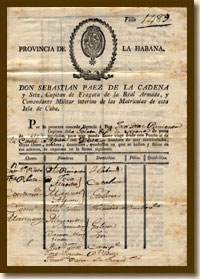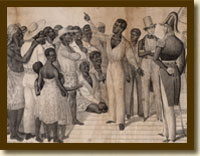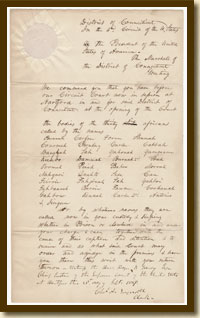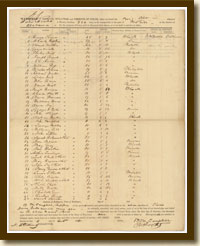Featured Story: Trafficking in Humans
In the 18th and early 19th century, slavery was a thriving enterprise. Even after January 1, 1808, when Congress prohibited the importation of slaves, slave traders continued to circumvent the law.
Travel Document for the Schooner Syrena, 1817
Law, Equity, Criminal, Habeas Corpus, and Admiralty Case Files National Archives, Records of District Courts of the United States, Record Group 21 (National Archives Identifier 2641469)
Carrying slaves from Africa, the Schooner Syrena was seized in the waters of the United States and brought into the port of Savannah. When the admiralty case was heard in 1820, there were several claims to ownership of the “Negroes, Mulatoes, or persons of color” on board the seized ship.
Certificate, U.S. v. Slaves of the Syrena,
May 12, 1820
Law, Equity, Criminal, Habeas Corpus, and Admiralty Case Files National Archives, Records of District Courts of the United States, Record Group 21 (National Archives Identifier 2641468)
Typically, enslaved Africans were given names by the slavers, and their African names were lost. Slaves transported on the Schooner Syrena were identified by their Anglicized names in court documents.
Cinque Addressing his Compatriots,
on board the Spanish Schooner Amistad,
August 26, 1839 (reproduction)
Lithograph by John Childs Courtesy of the Chicago Historical Society
In 1839 Portuguese slavers abducted a group of Africans from Sierra Leone and shipped them to Havana, Cuba. Fifty-three Africans were purchased and put aboard the Cuban schooner Amistad bound for a Caribbean plantation. En route, the Africans seized the ship, killed the captain and the cook, and sailed for Africa.
Joseph Cinque, Leader of the Amistad Captives,
ca. 1840 (reproduction)
Oil portrait by Nathaniel Jocelyn Courtesy of the New Haven Colony Historical Society
Plea to the Jurisdiction of Cinque and Others,
August 21, 1839
Thomas R. Gedney v. Schooner Amistad, Case Files National Archives, Records of District Courts of the United States, Record Group 21 (National Archives Identifier 2641485)
Seized on the Amistad off Long Island, New York, and accused of murder, Cinque and the mutinous Africans were then imprisoned on charges of murder. In January 1841, the Supreme Court ruled that “it was the ultimate right of all human beings in extreme cases to resist oppression and to apply force against ruinous injustice.”
Warrant for Habeas Corpus,
September 21, 1839
United States v. Cinque and the Africans, Case Files National Archives, Records of District Courts of the United States, Record Group 21 (National Archives Identifier 2641484)
The government of Spain, the planters, and the ship's captain claimed the Africans as their property. The Supreme Court ruled the claims were not legitimate as the Africans had never been enslaved but were free individuals, kidnapped and transported illegally.
Manifest of Negroes, Mulattos, and Persons of Color, taken on board the Brig Alo,
October 4, 1844
Coastwise Slave Manifests National Archives, Records of the U.S. Customs Service, Record Group 36 (National Archives Identifier 2641467)
The 1808 act, prohibiting importation of slaves, still allowed slaves to be moved within the United States. This coastwise trade was handled like any other commodity with manifests documenting human cargo.








